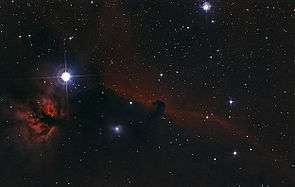Horsehead Nebula
| Dark nebula | |
|---|---|
| diffuse | |
|
The entire neighborhood of the nebula. The reflection nebula NGC 2023 is in the bottom left corner and the nebula itself near the center, in the shape of the head of a horse. | |
| Observation data: J2000.0 epoch | |
| Right ascension | 05h 40m 59.0s |
| Declination | −02° 27′ 30.0" |
| Distance | 1.5 kly ly |
| Apparent dimensions (V) | 8 × 6 arcmins |
| Constellation | Orion |
| Physical characteristics | |
| Radius | 3.5 ly |
| Notable features | Resembles a horse's head |
| Designations |
Barnard 33, LDN 1630, |
The Horsehead Nebula (also known as Barnard 33) is a dark nebula in the constellation Orion.[1] The nebula is located just to the south of the star Alnitak, which is farthest east on Orion's Belt, and is part of the much larger Orion Molecular Cloud Complex. The nebula was first recorded in 1888 by Scottish astronomer Williamina Fleming on photographic plate B2312 taken at the Harvard College Observatory. The Horsehead Nebula is approximately 1500 light years from Earth. It is one of the most identifiable nebulae because of the shape of its swirling cloud of dark dust and gases, which bears some resemblance to a horse's head when viewed from Earth.[2]
Overview
The dark cloud of dust and gas is a region in the Orion Molecular Cloud Complex where star formation is taking place. It is located in the constellation of Orion, which is prominent in the winter evening sky in the Northern Hemisphere and the summer evening sky in the Southern Hemisphere. This stellar nursery, as it is known, can contain over 100 known kinds of organic and inorganic gases as well as dust; some of the latter is made up of large and complex organic molecules.
The red or pinkish glow originates from hydrogen gas predominantly behind the nebula, ionized by the nearby bright star Sigma Orionis. Magnetic fields channel the gases leaving the nebula into streams, shown as streaks in the background glow.[3] A glowing strip of hydrogen gas marks the edge of the massive cloud, and the densities of nearby stars are noticeably different on either side.
The heavy concentrations of dust in the Horsehead Nebula region and neighbouring Orion Nebula are localized, resulting in alternating sections of nearly complete opacity and transparency.[4] The darkness of the Horsehead is caused mostly by thick dust blocking the light of stars behind it.[5] The lower part of the Horsehead's neck casts a shadow to the left.[6] The visible dark nebula emerging from the gaseous complex is an active site of the formation of "low-mass" stars. Bright spots in the Horsehead Nebula's base are young stars just in the process of forming. It has a magnitude of .11.
Gallery
 Horsehead Nebula and Alnitak (WH Pickering; 1888).
Horsehead Nebula and Alnitak (WH Pickering; 1888). View with a regular telescope and camera.
View with a regular telescope and camera. View from the HST (infrared).
View from the HST (infrared). View from the ESO (2002).
View from the ESO (2002).

See also
References
- ↑ Arnett, Bill (2000). "Horsehead Nebula". Retrieved July 21, 2014.
- ↑ Sharp, Nigel (2014). "The Horsehead Nebula". National Optical Astronomy Observatory. Association of Universities for Research in Astronomy. Retrieved July 21, 2014.
- ↑ "The Horsehead Nebula/IC434". National Optical Astronomy Observatory. NOAO. Retrieved 12 May 2014.
- ↑ Morgan, W.W.; Lodén, Kerstin (1966). "Some Characteristics of the Orion Association". Vistas in Astronomy. 8: 83–88. Bibcode:1966VA......8...83M. doi:10.1016/0083-6656(66)90023-7. ISSN 0083-6656.
- ↑ Mayo Greenberg, J (2002). "Cosmic dust and our origins". Surface Science. 500 (1-3): 793–822. Bibcode:2002SurSc.500..793M. doi:10.1016/S0039-6028(01)01555-2. ISSN 0039-6028.
- ↑ Nemiroff, R.; Bonnell, J., eds. (21 July 2009). "The Horsehead Nebula". Astronomy Picture of the Day. NASA. Retrieved 12 May 2014.
External links
| Wikimedia Commons has media related to Horsehead Nebula. |
- SOFIA/upGREAT [C II] Velocity Resolved Map of the Horsehead Nebula
- The Horsehead Nebula @ The Electronic Sky
- Hubble Observes the Horsehead Nebula
- The discovery of early photographs of the Horsehead nebula, by Waldee and Hazen
- The Horsehead Nebula in the 19th Century, by Waldee
- Detection of new nebulae by photography, by Pickering
- Horsehead Nebula at ESA/Hubble
- The Horsehead Nebula at the Astro-Photography site of Mr. T. Yoshida.
- The Horsehead-Nebula and neighboring structures in a classical view
- The Horsehead Nebula on interactive astro-photography survey at Wikisky.org
- The Horsehead Nebula at Constellation Guide
